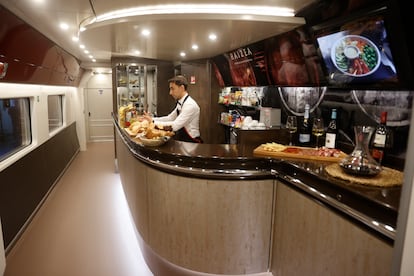There was a time when traveling by train was much more than reaching a destination. There was a time when it was also synonymous with a comprehensive experience tinged with luxury of which gastronomy was also a part.
From the mid-19th century, as railway lines spread across Europe and the United States, so did the first dining cars. On the old continent, the International Sleeping Car Company (CIWL, in its French acronym), founded in 1872 by the Belgian engineer Georges Nagelmackers, operated legendary trains such as the Orient-Express (which linked Paris with Istanbul) or the Train Bleu. (traveling from Calais to Ventimiglia), which not only guaranteed comfort and speed, but also an exceptional culinary experience. Over time, changes in traveling and eating habits reduced these rail restaurants to small canteens with a limited assortment of foods. snacks and reheated dishes.
A new illustrated book, Wagon-bar (Textuel), signed by railway historian Arthur Mettetal, reflects how technical advances and social changes marked the evolution of the gastronomic offer on board. The heyday of the dining car came during the first decades of the 20th century, when train menus competed with the best restaurants of the time. For example, passengers traveling on the Flèche d’Or, a train that connected Paris and London in just over seven hours (including the ferry transfer to Dover) could taste lobster, roast partridge and soufflé maraschino served on porcelain crockery and silver cutlery. At the Train Bleue, meanwhile, bow-tied waiters served foie grassmoked salmon and Danish duck, accompanied by a good wine and the occasional cigar.








The first dining cars weighed 59 tons, had electric ovens since the 1920s and cold storage rooms since the 1930s. The decline of the dining car began after World War II.
The democratization of transportation and the need to compete with the plane favored shorter trips that were more accessible to the general public. It would be the beginning of a strategy copied from the aerial model that continues to this day. “The change reflects the need for railway companies to rationalize their operations in a context where speed and efficiency are paramount, sometimes at the expense of traveler satisfaction due to price and lack of sophistication,” says Mettetal.
In the 1950s and 1960s, the idea of sitting down to a multi-course meal on a train began to seem absurd. The new fad was fast food and street vending carts. Instead of reserving a seat in the dining car, passengers bought a sandwich or a plate served on a disposable tray, a practice that became popular on European trains at the time.
The railway companies wanted to sell, through food, “a commercial offer at the forefront of modernity,” says the author of the book
In the mid-1970s, trains stopped preparing food on board. Having to serve hundreds of passengers meant that food production took place away from the train, as was the case with food on airplanes.
The photographs presented in the book, and in an exhibition that could be seen during the summer at the Arles Meetings, come from the collections of the former CIWL and the image archive of the SNCF, the French public train company. Part of these funds were on the verge of disappearing and were saved thanks to the mobilization of French railway employees in the nineties. Today they seem to be invaluable material for understanding social modernization in post-war Europe, when blind faith in progress after the cataclysm of the conflict served as social glue to face the future.
Halfway between industrial photography and advertising, the images embody a mutant modernity. The food served on trains reflected social and cultural changes over the decades. “The direct observation of a present frozen in time,” according to Mettetal. His study reflects the evolution of decoration on trains, the uniforms of railway staff, the organization of the dining car space and the prevailing menu at each historical moment.
These images reveal that the railway companies wanted to sell, through food, “an impeccable world of work and a commercial offer at the forefront of modernity,” says the author. Although, off-screen, one senses less positive aspects, from the aging of the carriages to the poor taste of the food.

Typical dishes
Eating habits change depending on the country. In Switzerland, the railway company decided to return to the white tablecloth and table service in the early 2000s. In another time there was the so-called Fromage Express, which served raclette in an all-you-can-eat buffet, while in Germany, Austria and other countries there was a McDonald’s car during the nineties. In Spain, the restaurant cars offer serrano ham, tortilla skewers and other local specialties, while in France they have opted in recent years to collaborate with renowned chefs such as Thierry Marx. And the Eurostar trains, which link Paris to London in just over two hours, for a time included a succinct selection of organic food, sponsored by Waitrose supermarkets.
In reality, the dining cars allow for “a kind of anthropological study,” says Mettetal. In the French context, the sandwich served on the current TGV (its equivalent to the AVE), mixed sandwiches covered in bechamel sauce and gratin cheese, whose recipe has not changed in 40 years, sell more than 600,000 units a year.
The aroma of that thawed sandwich in the grill of a train car becomes synonymous with travel, vacations and other adventures. “These images become a symbol, like the steak and chips that Roland Barthes analyzed in his mythologies”Mettetal writes in his book. “Although they are not particularly appetizing, these dishes provoke a positive, almost regressive feeling, tinged with a melancholic joy.” Above all, they exude a certain nostalgia for those times when we were able to believe in a better future.

